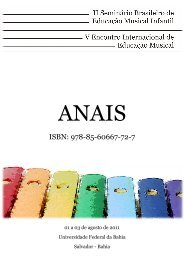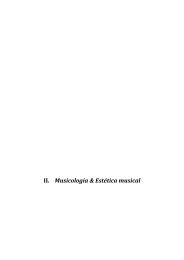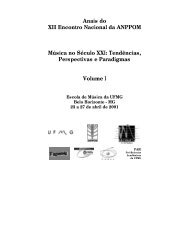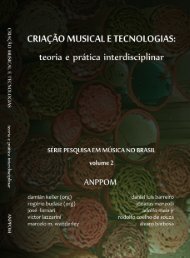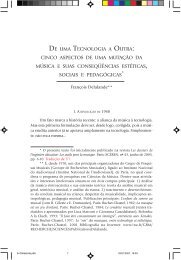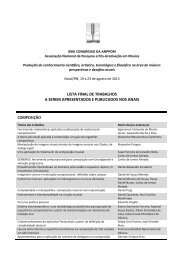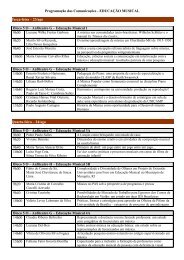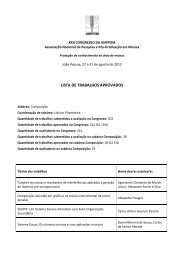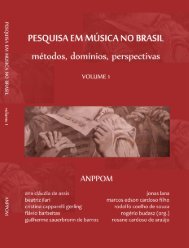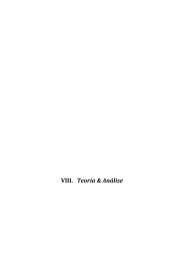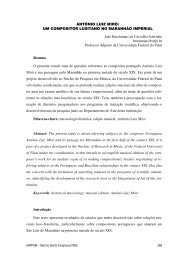download da versão impressa completa em pdf - anppom
download da versão impressa completa em pdf - anppom
download da versão impressa completa em pdf - anppom
You also want an ePaper? Increase the reach of your titles
YUMPU automatically turns print PDFs into web optimized ePapers that Google loves.
. . . . . . . . . . . . . . . . . . . . . . . . . . . . . . . . . . . . . . . . . . . . . . . . . . . . . . . . FORNARI; SHELLARD; MANZOLLI<br />
Using these sensors, it was possible to collect gestural <strong>da</strong>ta out of the <strong>da</strong>ncer's<br />
mov<strong>em</strong>ents, wirelessly and in real-time. The <strong>da</strong>taset excerpt shown in Figure 3 (right side)<br />
represents only one of the four sensors, compounded of 7 synchronous streams of <strong>da</strong>ta:<br />
three rotation angles: pitch, roll, yaw; three raw accelerations: x, y and z; and one general<br />
acceleration activity. They were mapped to create six arrays, corresponding to the lines of<br />
the gestural matrix M, which corresponds to the first individual genotypes in the Population<br />
set, at the beginning of its evolutionary process. Compounding the genotype, these gestural<br />
matrixes were fed with <strong>da</strong>ta collected from one specific body action recording. In this<br />
impl<strong>em</strong>entation, the mapping translated the mean variation of each sensor’s parameters –<br />
the ones attached to the <strong>da</strong>ncer's arms – for the Tonal Intensity and Tonal Frequency<br />
curves; and the ones attached to the <strong>da</strong>ncer's legs, were translated to Stochastic Intensity<br />
and Stochastic Frequency. Tonal Distortion was created by the difference between Tonal<br />
Intensity and Tonal Frequency. Stochastic Distortion was given by the difference between<br />
Stochastic Intensity and Stochastic Frequency.<br />
Computational Impl<strong>em</strong>entation<br />
We impl<strong>em</strong>ented an ESSynth model in PD because this is an open-source, multiplatform,<br />
visual programming environment, specially designed for the impl<strong>em</strong>entation of<br />
real-time multimedia <strong>da</strong>ta processing (www.pure<strong>da</strong>ta.info). A program developed in PD is a<br />
patch. This res<strong>em</strong>bles a <strong>da</strong>ta-flow structure, made with interconnected objects, message<br />
boxes, number boxes, symbol boxes, and so forth. An interesting feature of PD is the<br />
possibility of developing patches that can create and control other patches. This touches the<br />
paradigm of meta-programming, in which programming code can automatically write new<br />
code, without human supervision. There have been recent efforts to develop objects better<br />
acquainted for the meta-programming, such as the i<strong>em</strong>guts library, currently under<br />
development and written by IOhannes Zmölnig that aims to computationally <strong>em</strong>ulate the<br />
behavior of self-aware agents in a syst<strong>em</strong> (ZMÖLNIG, 2008). Nonetheless, PD is already<br />
capable of, introductorily, exploring the automatic generation of patches by other patches,<br />
which is particularly useful for the impl<strong>em</strong>entation of a<strong>da</strong>ptive syst<strong>em</strong>s, such as ESSynth.<br />
The Evolutionary Sound Synthesis, originally introduced by the group of Jônatas<br />
Manzolli (2001) is a computational method for sound synthesis based on principles of the<br />
Evolutionary Computation. In this work, we developed a new version of ESSynth with some<br />
new features. Instead of being fixed-size, here the Population set is variable-size. The<br />
evolutionary process can start with few Individuals, whose Genotypes were mapped from a<br />
select group of drawings. This eliminates the evolution is Generation steps. In turn, the<br />
Individuals here must have a lifespan. In this current impl<strong>em</strong>entation, offprings are begotten<br />
opus . . . . . . . . . . . . . . . . . . . . . . . . . . . . . . . . . . . . . . . . . . . . . . . . . . . . . . . . . . . . . . . . . . . . . . . . . . . . . 145



